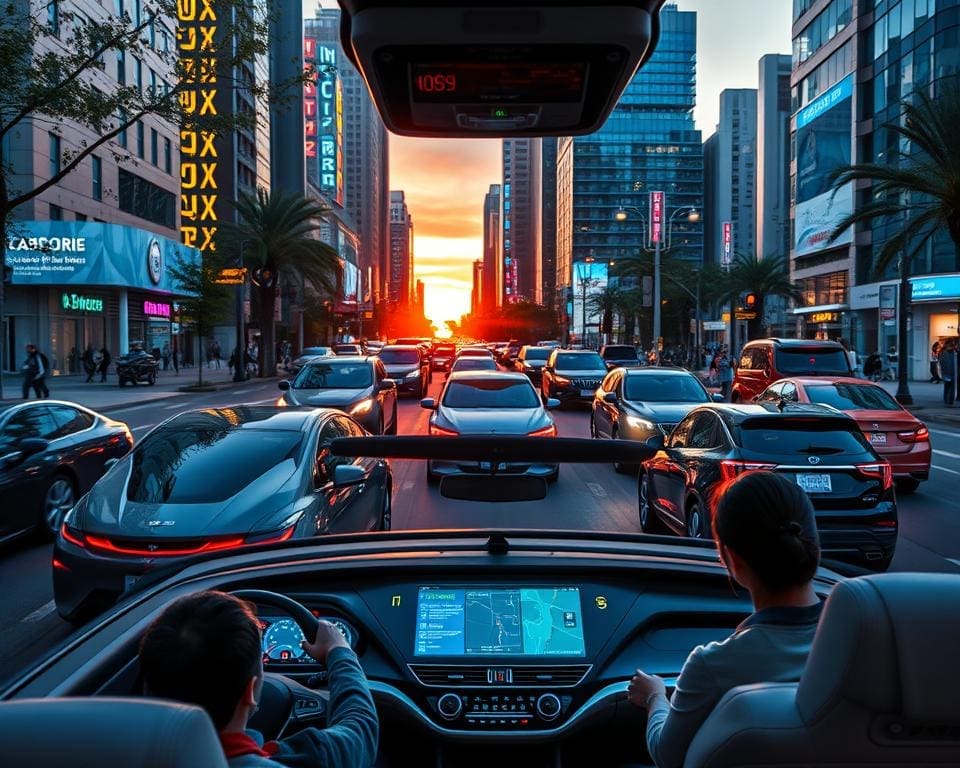The automotive industry is undergoing a profound transformation driven by artificial intelligence. As we embrace AI in Cars, advancements in technology are reshaping how we perceive commuting. From enhancing safety features to revolutionising user interactions, smart cars are at the forefront of this change. In this era of automotive innovation, the impact of self-driving technology cannot be overlooked. It signifies not just an evolution, but a genuine revolution that promises to redefine our daily travel experiences. Buckle up as we explore how these innovations are not just trends but the future of transportation.
The Rise of AI in Cars
The automotive landscape is undergoing a profound transformation with the rise of AI in cars. This technological evolution fundamentally alters how vehicles operate, offering exciting prospects for safety, efficiency, and user experience. Understanding artificial intelligence in the realm of automobiles reveals a powerful amalgamation of algorithms, machine learning, and data-driven insights that optimise vehicle performance.
Understanding Artificial Intelligence in Automobiles
At its core, understanding artificial intelligence involves utilising algorithms that enable machines to simulate human-like reasoning and decision-making. In automobiles, AI applications range from intelligent navigation systems to predictive maintenance features. Integration of machine learning enhances the driving experience, continuously refining capabilities based on real-time data and user interaction.
Historical Context of Automotive Innovation
The history of automobiles serves as a backdrop for the current wave of AI advancements. From the inception of the first motor vehicles to the introduction of electronic systems in the 20th century, each milestone has paved the way for innovative solutions. The shift to electric vehicles and the implementation of connectivity technologies further showcase the link between past innovations and the growing dominance of AI. Observing this evolution, one can appreciate how the rise of AI in cars not only transforms transportation but also influences user behaviours and environmental impact.

Enhancing Safety with AI Technologies
In the ever-evolving landscape of automotive safety, the integration of AI technologies plays a crucial role in ensuring safer driving experiences. Notable advancements include Advanced Driver Assistance Systems (ADAS) and AI-based collision avoidance systems, which are fundamentally transforming how vehicles operate on the road.
Advanced Driver Assistance Systems (ADAS)
ADAS represents a significant leap forward in enhancing safety for drivers and passengers alike. These systems utilise AI technologies to provide features such as:
- Lane-keeping assistance, which monitors the car’s position within the lane
- Adaptive cruise control, maintaining safe distances from other vehicles
- Automatic emergency braking, which activates during imminent collisions
These features contribute to reducing human error and increasing overall automotive safety, fostering a more secure environment for all road users.
AI-Based Collision Avoidance Systems
AI-based collision avoidance systems are at the forefront of accident prevention strategies. Utilising sophisticated algorithms, these systems analyse real-time data to predict potential accidents.
Key functionalities include:
- Object detection, identifying obstacles and potential hazards ahead
- Predictive analytics, assessing various driving scenarios to determine risks
- Automatic intervention, applying brakes or steering when necessary
Statistics support the effectiveness of these technologies, highlighting their potential in significantly reducing traffic incidents and saving lives. The journey toward improved automotive safety continues through these groundbreaking AI enhancements.
AI in Cars: Revolutionising the Commuting Experience
As technology advances, the introduction of smart cars represents a significant leap in the world of transportation. These vehicles are changing the landscape of daily travel, not only enhancing convenience but also enriching the overall commuting experience.
Smart Cars and Their Impact on Daily Travel
Smart cars are equipped with innovative features that dramatically improve the way we travel. Their integration of artificial intelligence allows for seamless navigation, real-time traffic updates, and personalised driving experiences. This transformation results in more efficient commuting, reducing travel times and increasing overall satisfaction.
User-Friendly Interfaces and Connectivity
The emergence of user-friendly interfaces in smart cars plays a crucial role in simplifying interactions between drivers and their vehicles. Intuitive controls enable quick access to vital information and features, allowing users to focus more on the journey ahead. In addition, advanced vehicle connectivity enhances communication with mobile devices and external systems, further enriching the daily travel experience.
Driverless Vehicles: The Future of Transportation
As technology advances, the concept of driverless vehicles becomes increasingly viable. These innovations promise to reshape how we view future transportation. Autonomous driving relies on a combination of sensory technologies and complex algorithms to navigate the world without human intervention.
How Autonomous Driving Works
Autonomous driving systems employ an array of sensors, including cameras, radar, and LiDAR, to perceive their surroundings. This data is processed through sophisticated AI algorithms that enable the vehicle to make informed decisions in real-time. By significantly reducing the potential for human error, driverless vehicles can enhance overall safety on the roads.
Benefits and Challenges of Self-Driving Technology
Self-driving technology offers numerous benefits, such as:
- Improved traffic flow through optimised driving patterns
- Increased mobility for individuals unable to drive
- Time savings as passengers can engage in other activities during transit
On the flip side, challenges persist. Regulatory hurdles hinder rapid deployment while public perception tends to be sceptical. Concerns about safety and the reliability of technology must be addressed to gain trust and widespread adoption. These benefits and challenges will shape the conversation around the future of transportation.
The Role of Machine Learning in Transportation
In the evolving landscape of transportation, machine learning plays a crucial role in transforming how we navigate our journeys. By leveraging advanced algorithms, transportation systems can become more efficient and user-friendly, thereby enhancing the overall commuting experience.
Predictive Analytics for Traffic Management
Predictive analytics serves as a powerful tool in traffic management by analysing vast amounts of data to forecast congestion patterns. These insights allow for timely adjustments to traffic signals and flow management, leading to a smoother travel experience. Cities can implement smart transportation solutions that optimise routes and reduce delays, ultimately promoting a more efficient transport network.
Personalised User Experiences
Machine learning in transportation enables the creation of personalised experiences for drivers and passengers alike. By studying individual driving habits and preferences, algorithms can deliver tailored recommendations—such as optimal routes or driving tips—that cater to each user’s unique needs. This approach not only enhances satisfaction but also fosters a deeper connection between users and their vehicles.
Connected Vehicles: Transforming the Way We Travel
The advent of connected vehicles marks a pivotal shift in the landscape of transportation. Enabling the seamless exchange of data, these vehicles demonstrate the true potential of modern technology in enhancing the way we commute. With a focus on vehicle-to-everything communication, connected vehicles transform travel, offering smarter modes of transport for all road users.
Vehicle-to-Everything (V2X) Communication
Vehicle-to-everything communication represents a leap forward in smart transportation. Through this system, vehicles can share vital information not only with other vehicles but also with infrastructure and pedestrians. This connectivity fosters a safer and more efficient travel environment.
The benefits of V2X communication are profound:
- Improved safety by alerting drivers to hazards or traffic conditions.
- Reduced accidents due to timely data sharing between connected vehicles.
- Enhanced traffic management, easing congestion and optimising routes.
As more vehicles incorporate this vehicle connectivity, the collective intelligence of the transportation ecosystem grows. *Transforming travel* into a streamlined and safer experience occurs through the integration of data sharing and advanced technologies. Embracing connected vehicles is not just about innovation; it signifies a commitment to creating a smarter future for everyone on the road.
The Economic Impact of AI on the Automotive Market
The integration of artificial intelligence within the automotive market brings about profound changes that affect not only the industry but also the economy at large. As AI technologies evolve, they lead to significant job creation and transformation of existing roles, illustrating the dynamic nature of this sector. Investment trends further emphasise the urgency for businesses to embrace innovation in order to remain competitive.
Job Creation and Transformation in the Industry
The economic impact of AI extends to myriad aspects of job creation within the automotive market. New positions emerge as companies seek talent skilled in AI management, data analytics, and machine learning. Roles that previously centred on manual processes are rapidly evolving, requiring a fresh set of skills. This transformation not only enhances productivity but also uplifts the workforce, with opportunities for professional development in emergent technologies.
Investment Trends in Automotive Technology
Investment trends demonstrate a marked shift in focus towards automotive technology driven by AI. As firms allocate resources to innovative solutions, the landscape of the automotive market continually changes. Investors are increasingly prioritising ventures that integrate AI capabilities, signalling a commitment to advancing automated features and connected vehicles. Such investments pave the way for sustained economic growth and prepare the sector for future challenges.
The Ethical and Regulatory Landscape of AI in Cars
The advent of AI in cars has ushered in a transformative era for the automotive industry, yet it also raises significant ethical questions and the need for a robust regulatory framework. As these intelligent systems become a standard feature in vehicles, concerns around data privacy and algorithmic decision-making become paramount. In critical situations, the manner in which an AI system interprets data and makes choices could have profound consequences for drivers, passengers, and pedestrians alike. Thus, addressing automotive ethics is not just an optional consideration but a crucial component of responsible innovation.
Industry regulations are evolving to ensure that the deployment of AI technologies aligns with safety and ethical standards. The dialogue between manufacturers, lawmakers, and the public is essential in formulating guidelines that hold companies accountable for the ethical implications of their AI systems. This ongoing collaboration aims to strike a balance between encouraging innovation in AI in cars while prioritising the safety and rights of drivers and the broader community.
Ultimately, a well-defined regulatory framework is not merely a legal obligation but an opportunity to build consumer trust in this new technology. As we continue to navigate this ethical landscape, it is vital for all stakeholders to engage in meaningful discussions that pave the way for ethical AI development. By prioritising consumer protection and ethical principles, we can ensure that the future of transportation through AI not only enhances the commuting experience but also upholds the values we cherish as a society.









